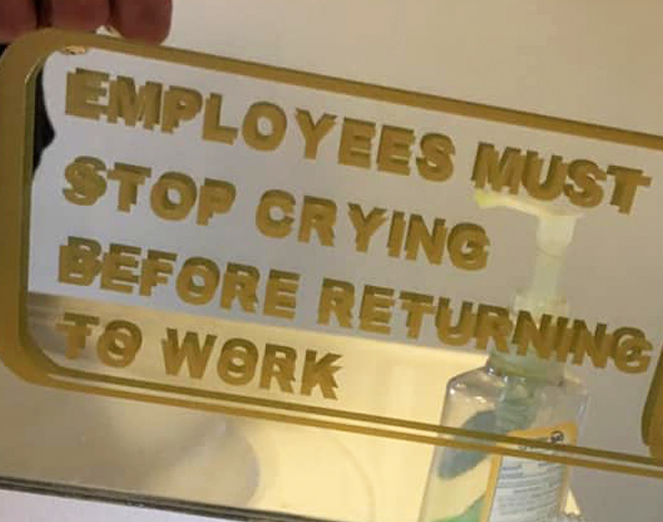One last point he makes is the personal savings rate soared during lockdowns, as key costs like childcare and commuting vanished. “When the world reopened, the costs returned, but now inflated by 20%. The rage we feel today is the hangover from that brief moment where the American Option was momentarily back in the money,” he says.
So people were actually better off during the pandemic. smh
You have to remember that a lot of people weren’t working or getting paid either, so even though their expenses went down many were still struggling.
Right, it’s also important to remember that for many folk they still had to go into work everyday, they tend not to be the people that have time to blog and wax nostalgic on the glory days of the pandemic. (Not directed at you or the parent, just a comment)
In which city? That is not remotely poverty wages in the mid west
deleted by creator
In the Bay Area this checks out
So food at home is no longer 33% of household spending, it’s somewhere between 5% and 7%.
The average price of eggs — a frequent stand-in for inflation during the campaign — had declined from its peak in the spring and is back below last November’s prices. Average orange juice prices are up 29% and ground beef prices are up nearly 14% from where the two were a year ago.
So we’ll see how long that lasts.
Green tested out his $140,000 theory, by looking at national average data on key costs — and calculated $32,773 for childcare, $23,267 for housing, $14,717 for food, $14,828 for transportation, $10,567 for healthcare and $21,857 for what he said were other essentials. Add in federal, state and FICA taxes, and it gets to a gross income of $136,500.
These costs can (and often are) mitigated through communal living and shared household capital. Just anecdotally, I can tell you that my mother-in-law has been pivotal in providing childcare for my toddler son. Daycare can cost north of $2000/mo. And if I don’t want to burn a vacation day staying home to care for him when he’s sick, I’m going out $200+/day for a nanny. But grandma can take over for the cost of lunch. And that’s for someone with kids. You don’t need childcare if you’re childless.
Similarly, wrt transportation, I’m close enough to work that I can bike to work. If any coworkers lived nearby, we could carpool. Every household carrying its own car, maintenance, gas, insurance, etc is more a consequence of our atomized lifestyle than a requirement for survival. We absorb the cost as a luxury. And my home town of Houston builds our city to incentivize consumption of these luxuries.
So I do question $140k as “poverty level” in a material sense. These aren’t survival costs, they’re overpriced amenities.
Another point he makes is that the safety net does catch people at the very bottom, but traps anyone who climbs out. For instance, at $45,000, they lose Medicaid eligibility; at $65,000, childcare subsidies vanish.
This has been historically described as the Welfare Trap or Benefits Cliff. Our policy of means testing public services results in certain cohorts being incentivized to downplay their income for the purpose of maximizing state benefits. This pushes people into cash-businesses, the gig economy, and other gray market channels for labor which are often unregulated or quasi-criminal in function. From there, you get a rising price of policing benefits as a share of their cost (leading to skyrocketing IRS audits of poor black residents concentrated in the Gulf Coast) on the one end and increasingly unreliable labor data used to calibrate optimal domestic labor policies on the other.
It is - curiously - a problem that liberals love to keep reinventing. The ACA, the COVID Stimulus, and the Biden plan for student debt relief all contained cut-offs and trade-offs that shoved people out of the traditional labor pool.
What the article fails to address is the question “What happens to people operating below the poverty line?” The original Orshansky definition carries with it some real material consequences - malnutrition, exposure to the elements, significantly higher rates of treatable diseases. Do we see that for household residents below $140k/year relative to the $83k/year average? The article doesn’t say.
I can tell you that my mother-in-law has been pivotal in providing childcare for my toddler son. Daycare can cost north of $2000/mo. And if I don’t want to burn a vacation day staying home to care for him when he’s sick, I’m going out $200+/day for a nanny. But grandma can take over for the cost of lunch. And that’s for someone with kids. You don’t need childcare if you’re childless.
This kind sounds like the $33k is about right then, it’s just that the value is provided by family (which is great don’t get me wrong). You can’t make these calculations on the assumption of these factors. What if you suddenly didn’t have free childcare? Would you be unable to then make rent?
And what if your work moved somewhere where you had to then drive?
How close are you to financial collapse if something bad happened?
There should probably be a different number for a single person, but then there’s less sharing in other ways as well.
it’s just that the value is provided by family (which is great don’t get me wrong)
The value provided by grandparents, plus the overhead of real estate and administration and profit. If you’ve ever actually talked with a daycare worker, you might be surprised to note that they can care for anywhere from four to twelve kids each. However, they aren’t seeing anything close to the $100/day each child yields in revenue. The primary cost of operating a daycare is typically the cost of the location - either explicit rents by the building owner or interest on debt borrowed to purchase the property.
And what if your work moved somewhere where you had to then drive?
What’s kinda ironic about Houston is that we’ve got these big commercial bus services positioned all through the suburban neighborhoods. I live to close in to take advantage of any of them. One of my bigger regrets in living where I do is that I didn’t get to take advantage of the two rail lines the city operates. We’ve been promised bus rapid transit or rail extension for over a decade, but it has never materialized. The bike trail is actually the closest thing to urban transit I’ve seen built since I moved in back in 2014.
How close are you to financial collapse if something bad happened?
Really depends on how it manifests. O&G has historically been pretty recession proof. But there are exceptions. The 80s boom years were terrible for Houston, because they rode in on the back of cheap energy. The Enron Scandal of '01 hit smack into the center of downtown. And the COVID shock gave us -$43/bbl gasoline, which sent local businesses into a free fall.
There should probably be a different number for a single person, but then there’s less sharing in other ways as well.
Living with roommates / a spouse brings down cost of living in a whole host of ways, no doubt. Just on its face, you only need one kitchen per household and kitchens can get very expensive.
It’s hard to get by without driving in Houston. Even if you considered it safe to bike (which it isn’t, the dedicated bike lanes are pretty limited), it’s impossible to avoid the weather. Do you just carry a change of clothes?
I actually used to live in Houston too and had a half mile commute (either bike or run), but still had to drive fairly often. And I consider that a luxury for the city. Otherwise you’re living in the suburbs and commuting for two hours everyday.
I’ve known only a handful of people who’ve tried doing carless in Houston and only one of them long term. And he lived in a co-op so most needs were met in other ways.
Even if you considered it safe to bike (which it isn’t, the dedicated bike lanes are pretty limited), it’s impossible to avoid the weather.
The MKT gets you all the way from 610 to downtown with virtually no interaction with cars until you’re actually in the city proper.
I’ll spot you weather, but I’ve biked in the rain before. A poncho is all you really need shy of severe weather. And if I’m taking an Uber to and from work once or twice a month, that’s far cheaper than owning a car.
I’ve known only a handful of people who’ve tried doing carless in Houston and only one of them long term
I think “carless” is much more difficult. But “one car house” is very possible. You don’t need a vehicle for every member of the family.
You don’t need childcare if you’re childless
Childless person here. My partner and I had no ability to count on our families for childcare, or more basic things. Our choice to not have children was more about our (tenuous) mental health and lack of emotional support from family, but economics played a part too.
You are lucky to have support from someone who has good health and the ability to watch your kids (they are retired? None of my family can afford that)
Children aren’t some sort of luxury. Our poverty line should allow for people to afford children.
I don’t agree with all of this guy’s numbers but you absolutely should include the cost of children in the poverty line.
Children aren’t some sort of luxury.
Daycare is, though. What you’re really talking about with daycare is paying for servants to watch your kids while you work or otherwise spend your time elsewhere.
There’s a real economic benefit in socializing the cost of care and professionalizing child care as a profession. But daycare prior to Pre-K is primarily occupying the child’s time and energy until the parents return. It’s a hard trade off between your time and someone else’s.
I don’t agree with all of this guy’s numbers but you absolutely should include the cost of children in the poverty line.
I think the point he hits on is the bizarre math of denying public child care to middle class Americans specifically. And I’m all for citing it as bad policy.
But it’s a very separate thing from household poverty, precisely because being unemployed (or relying on someone who is) effectively solves your child care cost problem.
We should factor child expenses in so that no one feels financially pressured out of having kids
What happens to people operating below the poverty line?
There are probably parallels. Personally, I see some hazardously skip healthcare to avoid the cost.
So he’s estimating 140k for married with children? Whats the individual estimate?
And so now, let’s tug on that loose thread… I’m sure many of my left-leaning readers will say, “This is obvious, we have been talking about it for YEARS!” Yes, many of you have; but you were using language of emotion (“Pay a living wage!”) rather than showing the math.
I gotta say, anyone who critiques leftism by claiming the leftists don’t show the math hasn’t ever actually read Marx. Nevermind Piketty or Graeber or Wolff.
Or anyone online who ever took a month’s rent in a no frills apartment and multiplied by 3
Tbh Vanilla Marx is a pretty far cry from modern American leftist. “Pay a living wage” is itself about as anti-Marxist a statement one can make
“Workers should have a greater share of their surplus value” is textbook Marxism. The idea of a “living wage” is tied back to the goal of de-fetishizing commodities. You want to recognize that stuff comes from people and pay them enough to exist in the world you’ve built. You don’t want at team of workers producing a commodity (for instance, winter coats) in such a way that certain individuals in the manufacturing chain can’t afford to live near the factory or purchase the output.
Fantastic read! Thank you for sharing.
Another point he makes is that the safety net does catch people at the very bottom, but traps anyone who climbs out. For instance, at $45,000, they lose Medicaid eligibility; at $65,000, childcare subsidies vanish. “In option terms, the government has sold a call option to the poor, but they’ve rigged the gamma. As you move ‘closer to the money’ (self-sufficiency), the delta collapses. For every dollar of effort you put in, the system confiscates 70 to 100 cents,” he says. “No rational trader would take that trade. Yet we wonder why labor force participation lags. It’s not a mystery. It’s math.”
What? How does the system take 70-100 cents of every dollar of effort put in by low income people? Medicaid and childcare subsidies going away isn’t 70-100% of the income of a household earning 65k.
Obviously losing medicaid or childcare subsidies is a huge blow for anyone, but i don’t understand where he’s pulling 70-100% of the value of someone’s labour from.
It is 70-100% of the extra money they make compared to someone earning around 30k.
I personally consider the poverty line to be when you can live safely and comfortably, which for most places around the world would be like $20,000 and for intercity New York would be like $80,000.
140k just seems a little absurd.
The 140k amount was for a family of four and including childcare for two children.
That sounds about right. Anyone who objects can stick it into an inflation calculator and compare to “back in my day”
Anyone who objects can stick it into an inflation calculator and compare to “back in my day”
Well, a big part of the article is that you can’t just do that because the original formula was iffy even for the time when housing and insurance costs were not nearly as much of the average person’s expenses. That part of the article (well at least the original article this was based from https://www.yesigiveafig.com/p/part-1-my-life-is-a-lie) that was so interesting was that it was originally based on about 3x times the minimum food budget. Apparently that was just an easier number to be able to quantify at the time in the 60s and they just kept using it.
For how many people?
Individual
Unless I am mistaken poverty lines are usually for families not individuals.
I think 140k median us wide for a family seems reasonable. Sure it’s pretty high for some Low Cost of Living areas, but many of those areas lack local social services, public transit, etc.
Would that not then be letting the high cost outliers dictate the number for the vast majority? $20k x4 is $80k
Sure. But the issue is the sample size is naturally large so the Central Limit Theorem applies.
As such, the population of the US as a whole is likely normally distributed. Thus the outliers are normalized and this should not skew anything.
140k/4 is about 35k a person. Since a household of 4 assume 2 kids and kids consume a median of 30k a year not including housing you are limiting each adult to about 40k a year pre tax. Tax is going to consume about 50k so that’s 30k for 2 adults for the year. Housing costs at 1800 a month for a 2 bedroom eat up about another 20k.
This leaves 10k for food, clothes, etc.
Assuming I didn’t jack up my math (bad assumption even if I teach finance as a living), there is simply not enough money to really enjoy life. At 80k you are living on a 60k deficit, which means you rely heavily on the good grace of others to function.
I think the most achievable method to get this standard of living to everyone in short term is to properly define the limit as it applies to everyone. Giving everyone a guaranteed $140k, $35k per adult and child, would be exhorbitant in many places, though slightly more understandable if you’re limiting to the USA alone, and still not cover the highest cost areas at all. Giving the majority of people $20k per person and child, is doable and could more easily gain public support, and is sufficient.
Muddying the definitions and pushing an ever higher number like this author is doing doesn’t seem beneficial for the goal of getting people out of poverty.
Frankly. I don’t think I internalized the source material enough to provide a fair take on the source and concede the author likely conflates the issue poorly.
Thank so much for the intellectual bout. Appreciate you.
deleted by creator









